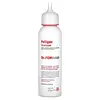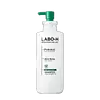What's inside
What's inside
 Key Ingredients
Key Ingredients

 Benefits
Benefits

 Concerns
Concerns

 Ingredients Side-by-side
Ingredients Side-by-side

Water
Skin ConditioningOnsen-Sui
Dipropylene Glycol
HumectantCaprylic/Capric Triglyceride
MaskingCetearyl Alcohol
EmollientCetyl Alcohol
EmollientStearyl Alcohol
EmollientBrassicamidopropyl Dimethylamine
Skin ConditioningBehentrimonium Chloride
PreservativeBehentrimonium Methosulfate
Parfum
MaskingBehenyl Alcohol
EmollientGlyceryl Stearate
EmollientSteartrimonium Chloride
PreservativeQuaternium-33
Alcohol
AntimicrobialPentylene Glycol
Skin ConditioningPropylene Glycol
HumectantIsopropyl Myristate
EmollientPanthenol
Skin ConditioningPropanediol
SolventZinc Pyrithione
AntiseborrhoeicCitric Acid
BufferingButylene Glycol
HumectantSalicylic Acid
MaskingMenthol
MaskingPolyquaternium-10
Guar Hydroxypropyltrimonium Chloride
Skin ConditioningCaprylyl Glycol
EmollientLanolin Acid
CleansingEthylhexylglycerin
Skin ConditioningDisodium EDTA
Laurdimonium Hydroxypropyl Hydrolyzed Wheat Protein
Cnidium Officinale Rhizome Extract
Skin ConditioningPanax Ginseng Root Extract
EmollientSodium Citrate
BufferingHydrolyzed Soy Protein
HumectantHydrolyzed Keratin
HumectantZinc Chloride
AntimicrobialSorbitol
HumectantBelamcanda Chinensis Root Extract
Skin ConditioningSwertia Japonica Extract
Skin ConditioningGlycerin
HumectantCocos Nucifera Oil
MaskingGardenia Taitensis Flower
Skin ConditioningHydrolyzed Rye Phytoplacenta Extract
Skin ConditioningGlycine
BufferingPaeonia Suffruticosa Root Extract
Skin ProtectingSerine
MaskingGlutamic Acid
HumectantNymphaea Alba Flower Extract
Skin ConditioningSerenoa Serrulata Fruit Extract
Skin ConditioningHibiscus Sabdariffa Flower Extract
Skin ConditioningAspartic Acid
MaskingLeucine
Skin ConditioningFagraea Berteroana Flower Extract
Skin ConditioningCananga Odorata Flower Extract
PerfumingAlanine
MaskingLysine
Skin ConditioningArginine
MaskingTyrosine
MaskingPhenylalanine
MaskingUrea
BufferingLecithin
EmollientPolysorbate 80
EmulsifyingThreonine
Proline
Skin ConditioningValine
MaskingIsoleucine
Skin Conditioning1,2-Hexanediol
Skin ConditioningCeramide NP
Skin ConditioningHistidine
HumectantMethionine
Skin ConditioningCysteine
AntioxidantCysteic Acid
Skin ConditioningSodium Succinate
BufferingPlumeria Alba Flower Extract
Skin ConditioningPlumeria Rubra Flower Extract
Skin ConditioningBiotin
AntiseborrhoeicTocopherol
AntioxidantWater, Onsen-Sui, Dipropylene Glycol, Caprylic/Capric Triglyceride, Cetearyl Alcohol, Cetyl Alcohol, Stearyl Alcohol, Brassicamidopropyl Dimethylamine, Behentrimonium Chloride, Behentrimonium Methosulfate, Parfum, Behenyl Alcohol, Glyceryl Stearate, Steartrimonium Chloride, Quaternium-33, Alcohol, Pentylene Glycol, Propylene Glycol, Isopropyl Myristate, Panthenol, Propanediol, Zinc Pyrithione, Citric Acid, Butylene Glycol, Salicylic Acid, Menthol, Polyquaternium-10, Guar Hydroxypropyltrimonium Chloride, Caprylyl Glycol, Lanolin Acid, Ethylhexylglycerin, Disodium EDTA, Laurdimonium Hydroxypropyl Hydrolyzed Wheat Protein, Cnidium Officinale Rhizome Extract, Panax Ginseng Root Extract, Sodium Citrate, Hydrolyzed Soy Protein, Hydrolyzed Keratin, Zinc Chloride, Sorbitol, Belamcanda Chinensis Root Extract, Swertia Japonica Extract, Glycerin, Cocos Nucifera Oil, Gardenia Taitensis Flower, Hydrolyzed Rye Phytoplacenta Extract, Glycine, Paeonia Suffruticosa Root Extract, Serine, Glutamic Acid, Nymphaea Alba Flower Extract, Serenoa Serrulata Fruit Extract, Hibiscus Sabdariffa Flower Extract, Aspartic Acid, Leucine, Fagraea Berteroana Flower Extract, Cananga Odorata Flower Extract, Alanine, Lysine, Arginine, Tyrosine, Phenylalanine, Urea, Lecithin, Polysorbate 80, Threonine, Proline, Valine, Isoleucine, 1,2-Hexanediol, Ceramide NP, Histidine, Methionine, Cysteine, Cysteic Acid, Sodium Succinate, Plumeria Alba Flower Extract, Plumeria Rubra Flower Extract, Biotin, Tocopherol
Water
Skin ConditioningSodium Cocoyl Isethionate
CleansingDisodium Laureth Sulfosuccinate
CleansingLauryl Betaine
CleansingGlyceryl Stearate
EmollientTrihydroxystearin
Skin ConditioningPolyquaternium-10
Caffeine
Skin ConditioningCetyl Alcohol
EmollientDicaprylyl Ether
EmollientSodium Benzoate
MaskingSodium Salicylate
PreservativeMentha Piperita Oil
MaskingMenthol
MaskingCitric Acid
BufferingCaprylic/Capric Triglyceride
MaskingCaprylyl Glycol
EmollientIllicium Verum Fruit/Seed Oil
MaskingRosmarinus Officinalis Leaf Oil
MaskingDextrin
AbsorbentJuniperus Virginiana Oil
MaskingTetrasodium EDTA
Mentha Arvensis Leaf Oil
MaskingEucalyptus Globulus Leaf Oil
PerfumingOcimum Basilicum Oil
MaskingAnthemis Nobilis Flower Oil
MaskingViola Odorata Leaf Extract
MaskingLactobacillus Ferment Lysate
Skin ConditioningGlycerin
HumectantCamellia Sinensis Seed Extract
HumectantTocopherol
AntioxidantCeramide NP
Skin ConditioningHydrogenated Lecithin
EmulsifyingPhytosphingosine
Skin ConditioningBiotin
AntiseborrhoeicWater, Sodium Cocoyl Isethionate, Disodium Laureth Sulfosuccinate, Lauryl Betaine, Glyceryl Stearate, Trihydroxystearin, Polyquaternium-10, Caffeine, Cetyl Alcohol, Dicaprylyl Ether, Sodium Benzoate, Sodium Salicylate, Mentha Piperita Oil, Menthol, Citric Acid, Caprylic/Capric Triglyceride, Caprylyl Glycol, Illicium Verum Fruit/Seed Oil, Rosmarinus Officinalis Leaf Oil, Dextrin, Juniperus Virginiana Oil, Tetrasodium EDTA, Mentha Arvensis Leaf Oil, Eucalyptus Globulus Leaf Oil, Ocimum Basilicum Oil, Anthemis Nobilis Flower Oil, Viola Odorata Leaf Extract, Lactobacillus Ferment Lysate, Glycerin, Camellia Sinensis Seed Extract, Tocopherol, Ceramide NP, Hydrogenated Lecithin, Phytosphingosine, Biotin
Ingredients Explained
These ingredients are found in both products.
Ingredients higher up in an ingredient list are typically present in a larger amount.
Biotin is a B vitamin that is naturally produced by our bodies. It is also called Vitamin H.
Our bodies use biotin in the metabolism process. It also helps our bodies use enzymes and move nutrients around. A biotin deficiency can lead to brittle hair and nails.
More research is needed on applying biotin topically. However, taking biotin orally has been shown to help nourish the skin, hair, and nails. They play a role in forming skin-hydrating fatty acids.
Biotin is water-soluble. It can be found in foods such as fish, eggs, dairy, nuts, and meat. Vitamin H stands for "haar" and "haut". These are the German words for hair and skin.
Learn more about BiotinThis ingredient is an emollient, solvent, and texture enhancer. It is considered a skin-softener by helping the skin prevent moisture loss.
It helps thicken a product's formula and makes it easier to spread by dissolving clumping compounds.
Caprylic Triglyceride is made by combining glycerin with coconut oil, forming a clear liquid.
While there is an assumption Caprylic Triglyceride can clog pores due to it being derived from coconut oil, there is no research supporting this.
Learn more about Caprylic/Capric TriglycerideCaprylyl Glycol is a humectant and emollient, meaning it attracts and preserves moisture.
It is a common ingredient in many products, especially those designed to hydrate skin. The primary benefits are retaining moisture, skin softening, and promoting a healthy skin barrier.
Though Caprylyl Glycol is an alcohol derived from fatty acids, it is not the kind that can dry out skin.
This ingredient is also used as a preservative to extend the life of products. It has slight antimicrobial properties.
Learn more about Caprylyl GlycolCeramide NP is a type of ceramide and formally known as ceramide 3.
Ceramides are intercellular lipids naturally found in our skin that bonds dead skin cells together to create a barrier. They are known for their ability to hold water and thus are a great ingredient for dry skin.
Ceramides are an important building block for our skin barrier. A stronger barrier helps the skin look more firm and hydrated. By bolstering the skin ceramides act as a barrier against irritating ingredients. This can help with inflammation as well.
If you would like to eat ceramides, sweet potatoes contain a small amount.
Read more about other common types of ceramides here:
Ceramide AP
Ceramide EOP
Cetyl Alcohol is a fatty alcohol. Fatty Alcohols are most often used as an emollient or to thicken a product.
Its main roles are:
Though it has "alcohol" in the name, it is not related to denatured alcohol or ethyl alcohol.
The FDA allows products labeled "alcohol-free" to have fatty alcohols.
Learn more about Cetyl AlcoholCitric Acid is an alpha hydroxy acid (AHA) naturally found in citrus fruits like oranges, lemons, and limes.
Like other AHAs, citric acid can exfoliate skin by breaking down the bonds that hold dead skin cells together. This helps reveal smoother and brighter skin underneath.
However, this exfoliating effect only happens at high concentrations (20%) which can be hard to find in cosmetic products.
Due to this, citric acid is usually included in small amounts as a pH adjuster. This helps keep products slightly more acidic and compatible with skin's natural pH.
In skincare formulas, citric acid can:
While it can provide some skin benefits, research shows lactic acid and glycolic acid are generally more effective and less irritating exfoliants.
Most citric acid used in skincare today is made by fermenting sugars (usually from molasses). This synthetic version is identical to the natural citrus form but easier to stabilize and use in formulations.
Read more about some other popular AHA's here:
Learn more about Citric AcidGlycerin is already naturally found in your skin. It helps moisturize and protect your skin.
A study from 2016 found glycerin to be more effective as a humectant than AHAs and hyaluronic acid.
As a humectant, it helps the skin stay hydrated by pulling moisture to your skin. The low molecular weight of glycerin allows it to pull moisture into the deeper layers of your skin.
Hydrated skin improves your skin barrier; Your skin barrier helps protect against irritants and bacteria.
Glycerin has also been found to have antimicrobial and antiviral properties. Due to these properties, glycerin is often used in wound and burn treatments.
In cosmetics, glycerin is usually derived from plants such as soybean or palm. However, it can also be sourced from animals, such as tallow or animal fat.
This ingredient is organic, colorless, odorless, and non-toxic.
Glycerin is the name for this ingredient in American English. British English uses Glycerol/Glycerine.
Learn more about GlycerinGlyceryl Stearate is a mix of glycerin and stearic acid.
It is used to stabilize the mixing of water and oil ingredients. By preventing these ingredients from separating, it can help elongate shelf life. It can also help thicken the product's texture.
As an emollient, it helps soften skin and supports barrier-replenishing ingredients.
In cosmetics, Glyceryl Stearate is often made from vegetable oils or synthetically produced.
This ingredient may not be fungal-acne safe
Fun fact: The human body also creates Glyceryl Stearate naturally.
Learn more about Glyceryl StearateMenthol is a compound found in mint plants, such as peppermint. In its pure form, it is a clear crystalline substance.
Menthol is known for its cooling sensation; however, the cooling is actually from your skin being sensitized. Menthol can worsen rosacea. We recommend speaking with a professional if you have concerns.
Menthol also has antimicrobial properties.
Learn more about MentholPolyquaternium-10 is an ammonium salt of hydroxyethylcellulose. It is a white and granular powder used as a film-former and anti-static agent.
This ingredient is commonly found in hair conditioning products. According to a manufacturer, its positive charge makes it great for absorbing hair proteins. The manufacturer also states this ingredient helps with curl retention.
For haircare friends: this ingredient is not a silicone.
Learn more about Polyquaternium-10Tocopherol (also known as Vitamin E) is a common antioxidant used to help protect the skin from free-radicals and strengthen the skin barrier. It's also fat soluble - this means our skin is great at absorbing it.
Vitamin E also helps keep your natural skin lipids healthy. Your lipid skin barrier naturally consists of lipids, ceramides, and fatty acids. Vitamin E offers extra protection for your skin’s lipid barrier, keeping your skin healthy and nourished.
Another benefit is a bit of UV protection. Vitamin E helps reduce the damage caused by UVB rays. (It should not replace your sunscreen). Combining it with Vitamin C can decrease sunburned cells and hyperpigmentation after UV exposure.
You might have noticed Vitamin E + C often paired together. This is because it is great at stabilizing Vitamin C. Using the two together helps increase the effectiveness of both ingredients.
There are often claims that Vitamin E can reduce/prevent scarring, but these claims haven't been confirmed by scientific research.
Learn more about TocopherolWater. It's the most common cosmetic ingredient of all. You'll usually see it at the top of ingredient lists, meaning that it makes up the largest part of the product.
So why is it so popular? Water most often acts as a solvent - this means that it helps dissolve other ingredients into the formulation.
You'll also recognize water as that liquid we all need to stay alive. If you see this, drink a glass of water. Stay hydrated!
Learn more about Water